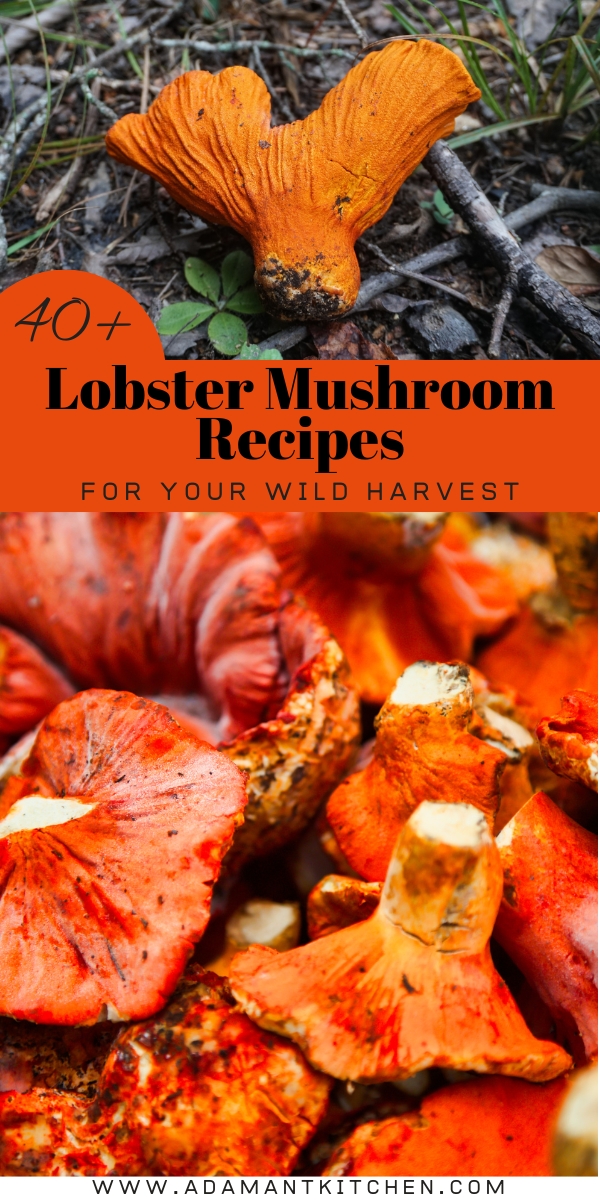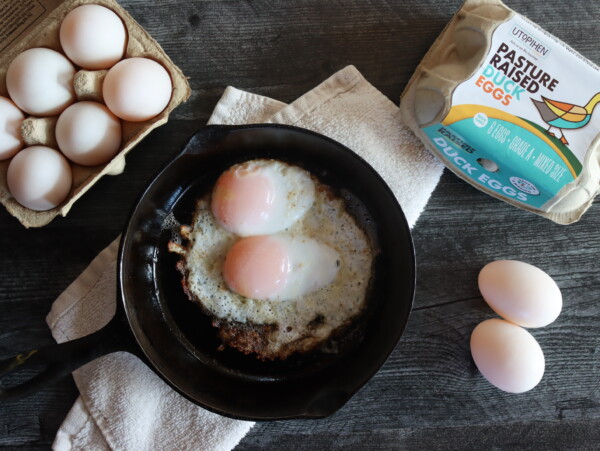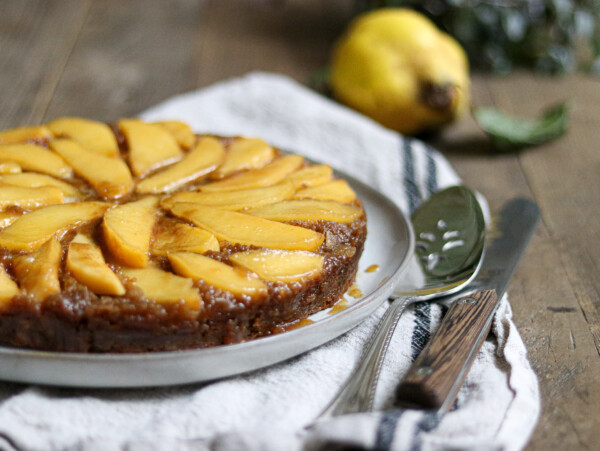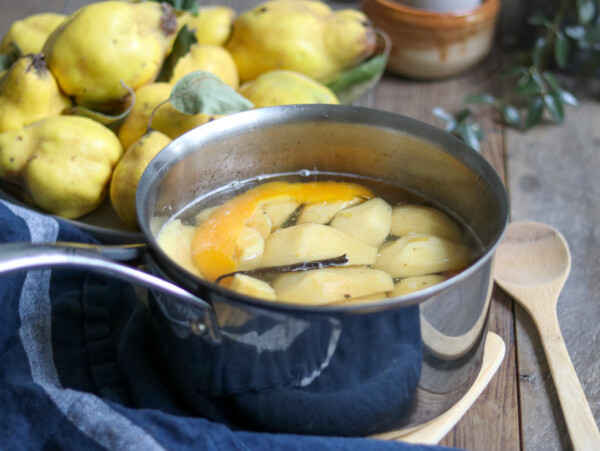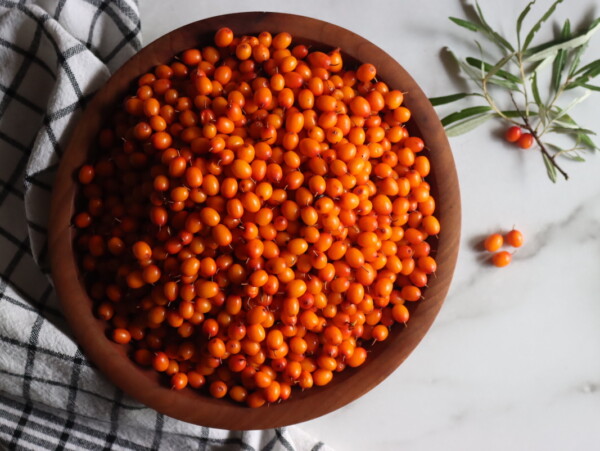This post may contain affiliate links. Please see our disclosure policy.
Lobster mushrooms are one startling and striking forest fungi. Believed to be found only in North America, these exceptional mushrooms are quite the sought-after prize.
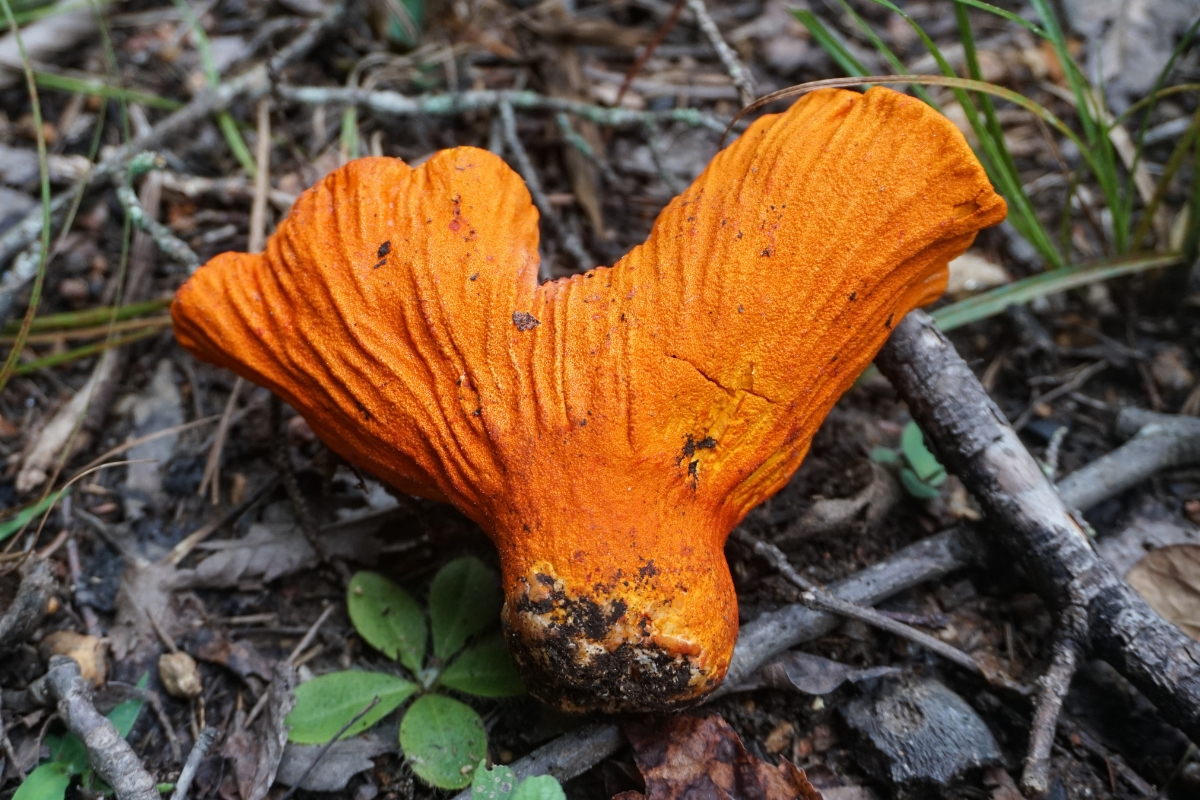
Lobster mushrooms are a vibrant delicacy cherished by both expert mycologists and beginner foragers. Their appearance is striking, easy to spot on a dark forest floor and the mushroom possesses no close lookalikes, making it a relatively safe bounty for those new to mushroom foraging.
These mushrooms are sometimes described as deformed due to their irregular shape with lumpy and wrinkly caps, ranging in shade from bright orange to fiery red. Inside the mushroom, the interior is completely white.
Lobster mushrooms are unique to North America and a bit of a strange fungi. What makes them so special is that they are actually parasitized mushrooms. Lobster mushrooms are the result when a specific fungus (Hypomyces lactifluorum) infects mushrooms of the species Russula or Lactarius, changing these relatively flavorless mushrooms into the shellfish-like delicacy mushroom enthusiasts savor.
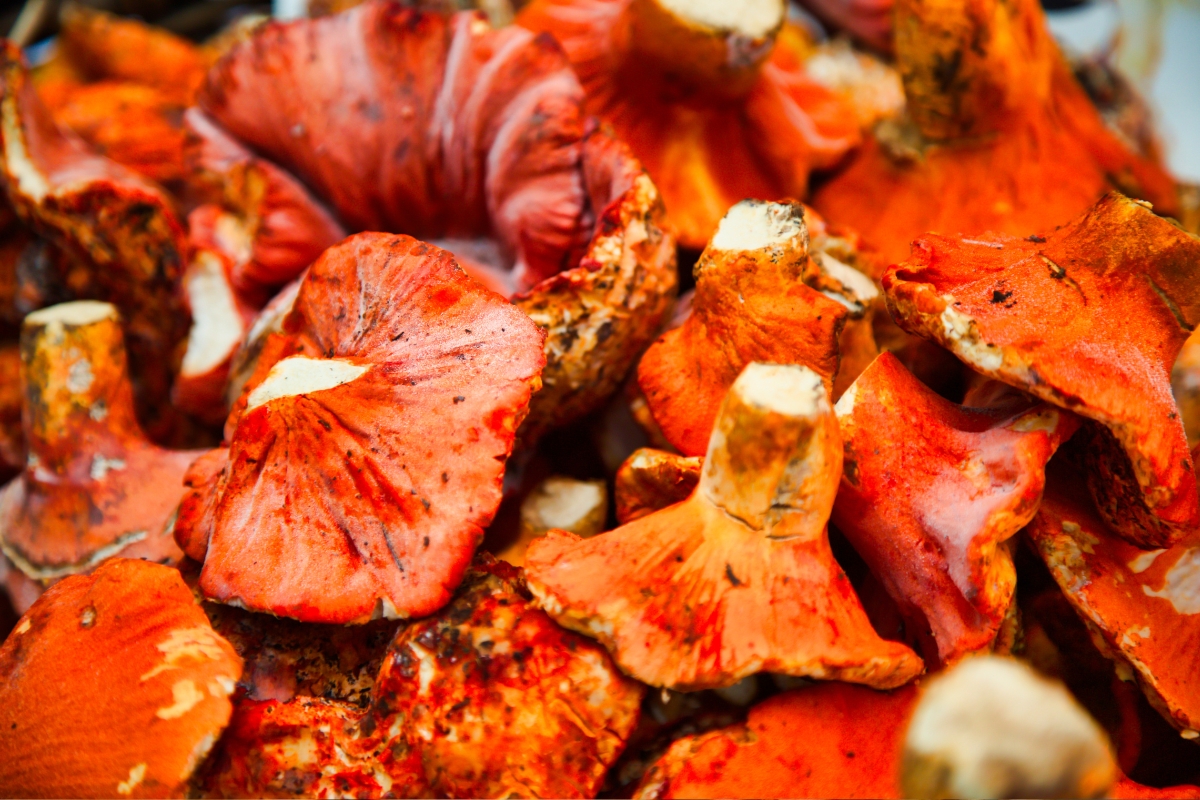
Choosing the Best Lobster Mushrooms
Lobster mushrooms have different fruiting seasons depending on their locations. In the Western United States, the season can occur anywhere between July to November, often peaking in September. In Colorado the season is shorter, beginning in July, peaking in August and finishing in September. In Canada and the Eastern US, lobster mushroom season begins in June, falling off when temperatures drop in the autumn.
You’ll find lobster mushrooms in the same locations you find their host mushrooms like the short stemmed russula (Russula brevipes complex) or the peppery milk cap (Lactifluus piperatus). These mushrooms grow in symbiosis with certain tree species like hardwoods and conifers, as well as oak, pine, hemlock and spruce, so look around areas where these trees are common.
Lobster mushrooms grow up from the forest floor, pushing up leaves and topsoil as they emerge. A small hump or slight poking up of orange may indicate a larger flush of mushrooms underneath so keep your eyes peeled.
As when foraging any new mushroom for the first time, be sure to bring an expert along to help you identify the mushroom you are in search of correctly. It is always better to be safe than sick!
Once you’ve sourced your lobster mushrooms, you can harvest them using only your hands. A knife is not necessary – simply reach underneath the mushroom and pull the entire mushroom from the ground. Brush as much dirt as you can before placing them in a breathable bag or basket.
Good lobster mushrooms should be heavy. Older mushrooms will possess a lighter, almost styrofoam-like feel and have a stronger fish odor – these should not be collected as they can make some individuals sick.
Look for mushrooms that are heavy and firm. Avoid purple-tinged mushrooms which are overly fishy and light. Mushrooms can then be taken home and properly cleaned.
Lobster mushrooms are best used within one week of picking.
Lobster Mushroom Recipes
Clean lobster mushrooms well before cooking – their irregular shape can hold onto dirt and debris more than other mushrooms. You can use a brush to get the majority of the soil off but feel free to use a splash of water as well. Run them under fresh water if needed and place them on a towel to dry. You can also remove any damaged or iffy bits of the mushroom with a paring knife or peeler.
Fresh lobster mushrooms harbor a mild shellfish flavor which can be intensified by drying the mushroom. Many recipes will use lobster mushrooms as a shellfish or lobster substitute for this reason, but you don’t have to be a seafood lover to enjoy this mighty mushroom. Cook them to add to soups, pasta, breakfast recipes and much, much more.
Just remember to always cook lobster mushrooms before eating – it is possible to become ill when eating them raw.
Lobster Mushroom Soup Recipes
You can use lobster mushrooms to create a variety of soups whether vegan or not. Try a slightly sweet, creamy lobster mushroom bisque made with coconut milk and chicken broth, or go for a chowder-style recipe with potatoes, fennel and vegetable stock. You can also add rice, fresh spices, turmeric or hot sauce.
Asian-inspired soups are another fantastic option. Try a Thai-based take on tom yum goong with lemongrass and shrimp or go for a Southeast Asian-inspired soup made with bone broth, cabbage and diced veggies. And for a truly fancy concoction, consider lobster mushroom soup cappuccinos made in an immersion blender or milk frother and served in cappuccino cups.
- Lobster Mushroom Bisque
- Lobster Mushroom Chowder
- Lobster Mushroom Manhattan Chowder (Dairy-free)
- Lobster Mushroom Soup
- Thai Sweet And Sour Soup With Lobster Mushrooms
- Southeast Asian Inspired Lobster Mushroom Soup
- Lobster Mushroom Cappuccino
Lobster Mushroom Breakfast Recipes
For delightful ideas to inspire your breakfast recipes, consider using lobster mushrooms in a diced potato hash to serve with morning eggs. Looking for something less starchy? Simply add lobster mushrooms to scrambled eggs or a mushroom omelet.
Make a lobster mushroom hollandaise for your next eggs benedict or to slather on eggs and hashbrowns. For larger breakfast fare, consider a lobster mushroom frittata embellished with bacon. There will be plenty for the whole family since this recipe serves 6 to 8.
- Eggs with Lobster Mushroom Hash
- Scrambled Eggs with Lobster Mushrooms
- Wild Mushroom Omelet
- Lobster Mushroom Hollandaise
- Lobster Mushroom and Bacon Frittata
Lobster Mushroom Snack Recipes
It’s too late for lunch, too early for dinner, and you’re craving something snackable. Fortunately, lobster mushrooms can be used in a variety of appetizers and snack recipes. Consider using lobster mushrooms for vegan tacos – they are gluten-free, dairy-free and vegan so absolutely no one can say no to them!
You can also make seafood-inspired lobster mushroom ceviche or a vegan sushi lobster mushroom tempura roll. There are also lobster mushroom wontons, decadent lobster mushroom dip made with truffle oil and cream cheese or lobster mushroom terrine. For a truly special occasion, consider lobster mushroom tarts made with fig and taleggio with millet and quinoa tart dough.
- Vegan Lobster Mushroom Tacos
- Lobster Mushroom Ceviche
- Vegan Lobster Tempura Roll
- Lobster Mushroom Wontons
- Lobster Mushroom Dip
- Lobster Mushroom and Zucchini Terrine
- Lobster Mushroom Summer Tarts
Lobster Mushroom Savory Main Courses
Do you dream of Maine lobster rolls but consider the real thing a little too pricey? Same. Luckily, if you have some lobster mushrooms nearby, you can make a faux lobster roll from diced lobster mushrooms, celery and mayo. You can also make lobster mushroom cakes in place of crab cakes.
Lobster mushrooms can be used in risotto, pastry boats, or a savory pavé layered with sliced mushrooms, cheese and eggs. You can even use ground lobster mushrooms in a rub for battered fish like burbot or walleye. You can make a buerre blanc sauce from lobster mushrooms to serve over chicken, vegetables or fish. Creole-style étouffée is yet another option best served over rice.
- Lobster Mushroom Rolls
- Lobster Mushroom Cake
- Asparagus and Lobster Mushroom Risotto
- Lobster, Mushroom and Sweet Corn Pastry Boats
- Lobster Mushroom Pave
- Lobster Mushroom Burbot with Crayfish Butter
- Lobster Mushroom Crusted Walleye
- Chickenless Pine Nut Chicken with Lobster Mushroom Buerre Blanc Sauce
- Skillet Shrimp and Lobster Mushroom Étouffée
Lobster Mushroom Pasta Recipes
Pasta recipes that make use of this colorful mushroom are plentiful indeed. A creamy rosè sauce can be made with lobster mushrooms and a mix of tomato and cream to serve over fettuccine and linguine. Mushrooms can be sauteed to top creamy pasta made from heavy cream and shredded parmesan cheese or top tomato-laden spaghetti.
Tagliatelle and pappardelle offer even more options. Toss with a simple lobster mushroom sauce or create a spring-derived pea and carrot pasta. Lobster mushroom mac and cheese is one last pasta option you’d be sore to miss. Both vegan and non-vegan options are savory and delicious. You can even add in some real lobster for an extra indulgent lobster mushroom mac and cheese recipe as well as cheddar or gouda.
- Creamy Lobster Mushroom Rosè Pasta
- Lobster Mushroom Cream Pasta
- Lobster Mushroom Fra Diavolo
- Tagliatelle with Lobster Mushrooms & Burrata
- Pappardelle Alfredo with Lobster Mushrooms
- Spring Pea and Lobster Mushroom Pasta
- Vegan Cashew Mac and Cheese With Lobster Mushrooms
- Lobster Mushroom Mac and Cheese
Lobster Mushroom Side Dishes
Many side dishes can be enhanced with the subtle flavor of lobster mushrooms. Vegan lobster mushroom salad can be served with crackers or over a bed of greens. Diced and cooked lobster mushrooms can be used to top salads much in the way shrimp or salmon can. Try lobster mushroom rice pilaf to complement fish courses or braise with tomatoes and leek to top polenta.
A tofu and mushroom combination can be made as well to go with soba noodles. You can also infuse lobster mushrooms into butter for cooking side dishes and more. Lobster mushroom breadcrumbs can be made from ground lobster mushrooms and panko breadcrumbs – stunningly good on fish, pasta or gratin.
- Vegan Lobster Salad
- Lobster Mushroom Salad
- Sauteed Lobster Mushroom Side Dish
- Lobster Mushroom Rice Pilaf
- Braised Lobster Mushrooms with Tomato and Leek
- Tofu with Lobster Mushrooms in Ginger Broth
- Lobster Mushroom Infused Butter
- Dried Lobster Mushroom Breadcrumbs
Cultured & Fermented Lobster Mushroom Recipes
There really is only one way to ferment lobster mushrooms: pickling. One recipe by Wine Forest Wild Foods outlines how to pickle lobster mushrooms in the classic Italian way. This includes first pickling the mushrooms in vinegar and then preserving them in aromatic oil.
They can be eaten right out of the jar or served with antipasto and cured or smoked meats. You can also try the method explained in Portland Monthly for making pickled umami bomb mushrooms, a post written in preparation for the Portland Fermentation Fest.
Preserving Lobster Mushrooms
The best way to preserve lobster mushrooms is by drying or dehydrating them. As mentioned before, this actually intensifies their flavor and mushrooms can be easily rehydrated for a number of recipes.
Some also recommend freezing lobster mushrooms uncooked to extend their life for a few months, although drying will last the longest.
You can also preserve lobster mushrooms in the form of a powder or rub for seasoning fish, poultry and other delightful dishes. This rub made from dried lobster mushrooms lasts quite a while in a pantry and can be made when needed or kept for long-term storage.
